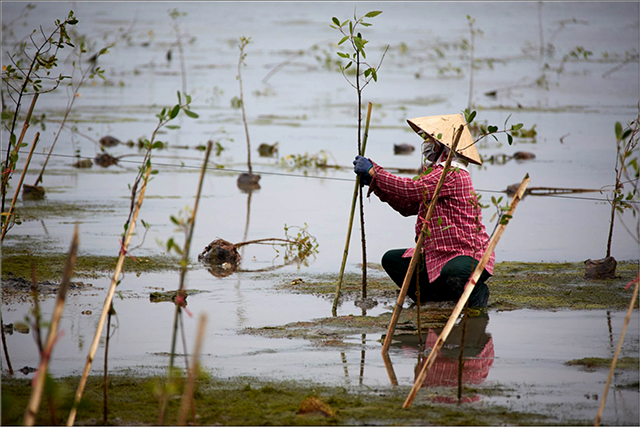
Support for planting mangroves in Loc Vinh commune
Ecosystem-based adaptation
The project of “Enhancing Flood Resilience in Urban and Coastal Areas in Thua Thien Hue Province” is a part of the “Global Water Resource Management” program with total budget of VND 4.5 billion. It was jointly implemented by CSRD and the Institute of Earth and Environmental Sciences (University of Postdam - Germany), with an integration of the ecosystem-based adaptation (EbA) initiative for resilience improvement. Applying the bottom-up approach, it focused on enhancing women's roles in disaster risk management (DRM) and climate change adaptation (CCA).
Ms. Pham Thi Dieu My, Director of CSRD pointed out that Thua Thien Hue province is heavily affected by typhoons and floods. The flood in November 2017 alone affected 160,000 households, causing an economic loss of VND 830 billion and 9 deaths. While a majority of Thua Thien Hue's population has unstable livelihoods, there is a lack of financial savings and reserves for life problems or disruptions that may occur.
Objective factors include gender equity, flood management, and rapid disappearance of natural areas and ecosystems that support people’s livelihoods. Although the number of people affected by floods is increasing, people still lack necessary knowledge of flood recovery.
Two EbA solutions have been deployed within the project. In the rural areas of Hue City, it made an evaluation in the ecosystem-based adaptation values through the restoration of natural flows and drainage areas, piloted the renovation and maintenance of the natural water drainage and storage systems in Hue City, and increased the urban flood resilience by strengthening women’s roles in flood management.
Regarding lagoon areas, the project included such components as planting mangrove forest and utilizing existing ecosystems to improve flood resilience and reduce erosion, etc. In addition, a survey was conducted to investigate factors affecting the flood resilience, with a focus on the difference between men and women, and training on flood adaptation and recovery.
Increasing adaptability
At the workshop, all participants confirmed that women are vulnerable and suffer from psychological and emotional problems to their voices not being heard in the society. Therefore, prior to planning risk management, it was recommended to consider gender-based resilience and long-term impact, with a women-centred approach. The expansion of participants in knowledge and skills training sessions would reduce pressures on women in natural disaster resilience and recovery. Apart from other family members, local authorities should involve women in planning phases for an easer access to a number of knowledge sources and raising their awareness in risk management.
Dr. Philip Bukeck from the University of Postdam - Germany, the Project manager shared that such structural measures as dykes and reservoirs are key means to reduce floods; however, they may cause some negative impacts on the environment, affecting vulnerable communities. The parallel approach of sustainable management of natural resources and ecosystem restoration that provided disaster adaptation services would be a feasible measure.
Particularly, developing mangrove forests is an effective alternative approach that both increases disaster resilience and speeds up post-disaster recovery. Local people are able to cope with the risks better through preserving and promoting values of the ecosystem. However, there is no plan for planting mangrove forests at present yet, or the scattered planting area easily creates duplicate deployment. In addition, the supply of seedlings in the area is not sufficient and the protection of mangroves still faces difficulties.
Based on this reality, Mr. Le Quang Tien - a project staff, recommended that local authorities and related agencies should develop a plan and identify the location of the concentrated mangrove forest. The management of mangroves should involve both the government and local people as a prerequisite to develop local ecosystems and sanctuaries for aquatic species, contributing to the improvement of long-term livelihoods.
Mr. Nguyen Luong Minh, Director of the Disaster Prevention and Search and Rescue Committee, said that in fact, the waterway system along Hue Citadel was mostly degraded and deposited to limit the ability of water storing and draining for the inner city. For an effective adoption of the EbA approach, it is necessary to dredge the Ngu Ha river system, along with restoring drainage pivots, and stopping the leveling and encroachment of reservoirs. Local governments should establish communication groups to raise people’s awareness on waterways protection.
Story, photo: Hoang Loan
